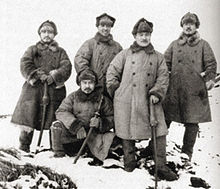Paul Nobuo Tatsuguchi
He returned to his native Japan to practice medicine at the Tokyo Adventist Sanitarium, where he received further medical training.
Throughout the ensuing battle, Tatsuguchi kept a diary in which he recorded its events and his struggle to care for the wounded in his field hospital.
Translated excerpts from his diary have been widely quoted in Western historical accounts of the battle, especially his final entry in which he recorded a farewell message to his family.
In 1907, after completing a course of study in dentistry at the College of Physicians and Surgeons in San Francisco, Shuichi Tatsuguchi returned to Hiroshima with plans to serve as a medical missionary.
He returned to California in 1933 and entered the College of Medical Evangelists at Loma Linda University, completing the course of study in June 1937.
While studying in America, Tatsuguchi was regarded by his classmates, who called him "Tatsy" or Paul, as a serious student, friendly but not gregarious.
As he would be working with tuberculosis patients in Tokyo, Tatsuguchi spent several more months undergoing postgraduate medical studies in California.
Also in 1938, Tatsuguchi married a childhood friend, Taeko Miyake, who he proposed to during a trip to Yosemite National Park.
Tatsuguchi concentrated on his work at the sanitorium, and, with Taeko, supported activities for the Adventist church, of which they were devout members.
[7] Early the next year, the IJA—the conscription authority in Japan—ordered Tatsuguchi to leave his medical practice and report to the First Imperial Guard Regiment (FIGR) in Tokyo, where he was inducted with the rank of private on January 10, 1941.
[9] Over the next several months, Tatsuguchi was deployed to the South Pacific in support of IJA units in the Dutch East Indies.
Tatsuguchi was unable to tell his wife, now pregnant with their second child, where he would be assigned, but she noticed that he studied maps of the North Pacific area.
As he was forbidden from discussing his unit's exact location or mission, Tatsuguchi wrote about the weather, the beauty of the snowy and mountainous landscape around him, and his success in catching fish.
The Japanese commander on Attu, Yasuyo Yamasaki, positioned his troops—who were outnumbered five to one—in the mountains from where they temporarily delayed the Americans' advance inland.
Tatsuguchi's diary entry on May 12 records the Japanese move into the mountains after the American landings, stating simply "evacuated to the summit.
"[16] Tatsuguchi recorded in his diary that he was forced to move his field hospital into a cave to escape American naval and aerial bombardment.
[17]Tatsuguchi refers again and again in his diary to the constant, intense attacks by American aircraft and artillery on his comrades' positions.
Yamasaki, apparently realizing that help from Japan was not forthcoming, decided on one last, desperate measure to try to save his command from destruction.
Later in the day on May 30, two American soldiers, Charles W. Laird and John Hirn, who were searching for remaining Japanese forces following the defeat of Yamasaki's attack, approached the cave containing Tatsuguchi's field hospital.
Tatsuguchi emerged from the cave, waving his Bible in the direction of the Americans and yelling in English, "Don't shoot!
Laird stated that he was sleeping in a tent the morning of May 30 when Yamasaki's troops broke through the American front lines.
[24] J. Mudry and another of Tatsuguchi's Loma Linda classmates, J. L. Whitaker, were medical officers with the US Seventh Division on Attu during the battle.
[24] After Tatsuguchi's death his Japanese diary, as well as his Bible, a copy of Gray's Anatomy and an address book, were forwarded to the division intelligence section.
Unauthorized copies of both Umetani's version and subsequent translations, some of which contained variations, were passed around among the American troops on Attu and to military installations on other Aleutian islands.
In early September 1943, the ADC's intelligence section reported that efforts to control the distribution of translated copies of the diary had failed.
[27] Several American newspapers published excerpts from the diary, and most highlighted the possibility that Tatsuguchi, a professed Christian, might have been involved in the killing of wounded patients.
The Chicago Tribune on September 9, 1943, published an article headlined "Japs Slew Own Patients on Attu, Diary Discloses".
Most Western historical accounts of the Battle of Attu mention Tatsuguchi and quote from his diary, especially the final entry.
Just after the war ended, B. P. Hoffman, one of Tatsuguchi's former college instructors and a friend of Taeko's, visited her in Osaka where she was living.
In 2005, Taeko told Kyodo News of her husband, "He was a faithful Christian doctor and a gentleman who devoted himself to God and communities.




